How to eliminate Destiny Stealer from infected computers
TrojanAlso Known As: Destiny information stealer
Get free scan and check if your device is infected.
Remove it nowTo use full-featured product, you have to purchase a license for Combo Cleaner. Seven days free trial available. Combo Cleaner is owned and operated by RCS LT, the parent company of PCRisk.com.
What kind of malware is Destiny Stealer?
Destiny Stealer is an info-stealing malware targeting Discord, web browsers, cryptocurrency wallets, and various files. Cybercriminals can exploit the stolen information for various malicious purposes, such as identity theft, financial fraud, and unauthorized account access. Victims are advised to run a system scan to remove the malware as soon as possible.
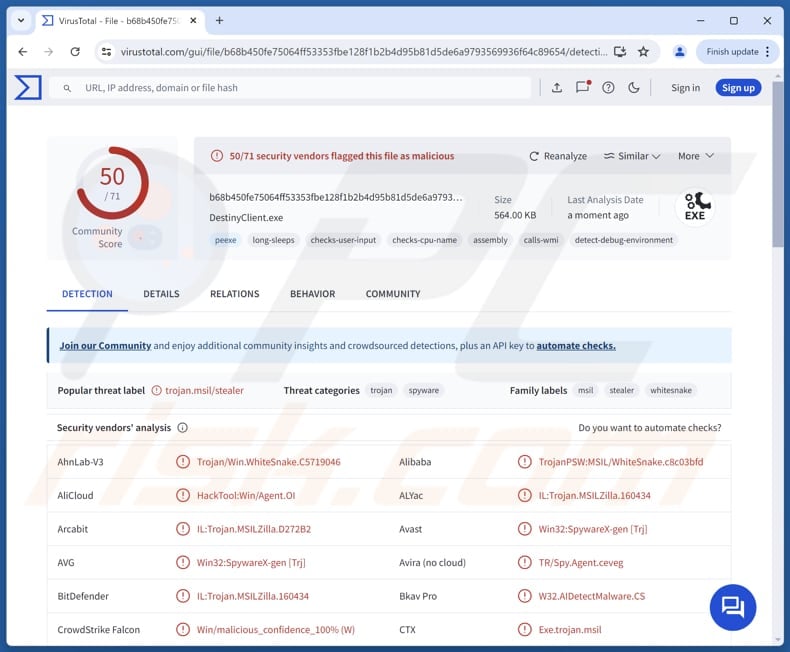
More about Destiny Stealer
Destiny Stealer can steal Discord tokens, which are unique identifiers used to authenticate a user’s session on the platform. Threat actors can use the stolen tokens to access the victim’s Discord account, which can lead to a range of malicious activities, including sending spam messages, stealing direct messages, using the account to spread malware, and more.
Also, the malware can extract browser data, including passwords, cookies, and autofill data. Cybercriminals can misuse these details to gain access to a victim’s online accounts, such as social media, banking, or email. Once inside, they can steal more personal data, send fraudulent messages, make fraudulent purchases, etc.
With autofill data, attackers can steal sensitive information such as credit card numbers, addresses, personal identification details, and other information saved within targeted browsers. Furthermore, Destiny Stealer targets cryptocurrency wallets, potentially to steal accounts' private keys and login credentials.
Threat actors can transfer digital assets (e.g., Bitcoin or Ethereum) to their accounts by gaining access to a victim's wallet. This can lead to significant financial loss, as cryptocurrency transactions are irreversible and difficult to trace.
Furthermore, Destiny Stealer gathers information about the infected PC, including system specifications, IP address, and installed software. It can also search for and steal files from documents, downloads, desktop folders, and other sources, potentially exposing sensitive data.
| Name | Destiny information stealer |
| Threat Type | Information Stealer |
| Detection Names | Avast (Win32:SpywareX-gen [Trj]), Combo Cleaner (IL:Trojan.MSILZilla.160434), ESET-NOD32 (A Variant Of MSIL/Spy.Agent.CXJ), Kaspersky (HEUR:Trojan-PSW.MSIL.Stealer.gen), Microsoft (Trojan:MSIL/WhiteSnake.DH!MTB), Full List (VirusTotal) |
| Symptoms | Stealers are designed to stealthily infiltrate the victim's computer and remain silent, and thus no particular symptoms are clearly visible on an infected machine. |
| Distribution methods | Infected email attachments, malicious online advertisements, social engineering, software 'cracks'. |
| Damage | Stolen passwords and banking information, identity theft, monetary loss, account takeover, and possibly other issues. |
| Malware Removal (Windows) |
To eliminate possible malware infections, scan your computer with legitimate antivirus software. Our security researchers recommend using Combo Cleaner. Download Combo CleanerTo use full-featured product, you have to purchase a license for Combo Cleaner. 7 days free trial available. Combo Cleaner is owned and operated by RCS LT, the parent company of PCRisk.com. |
Conclusion
Destiny Stealer is an info-stealing malware designed to collect sensitive data from infected systems. By compromising browsers, cryptocurrency wallets, and system data, the malware poses serious risks to both individuals and organizations. Users should be careful online and use reliable security tools to protect against threats like the Destiny Stealer.
More examples of information stealers are Pentagon Stealer, CatLogs Stealer, and ScarletStealer.
How did Destiny Stealer infiltrate my computer?
Cybercriminals distribute malware using various methods. For instance, they send deceptive emails containing malicious attachments or links to trick users into downloading and executing malware. They also employ technical support scams, malicious advertisements, pirated software, cracking tools, and keygens.
Malware is also deployed using malicious advertisements, software or operating system vulnerabilities, infected USB drives, stolen (or fake) social media accounts, compromised or deceptive web pages, P2P networks, third-party downloaders, and similar channels.
How to avoid installation of malware?
Download software only from official websites or trusted app stores, as third-party sources and pirated software can introduce malware. Avoid interacting with pop-ups, ads, or links on untrustworthy websites, and never allow suspicious pages to send notifications.
Be cautious with emails—verify the sender’s legitimacy, especially if the message is irrelevant or unexpected and contains links or files. Keep your software up to date and perform regular malware scans with a trusted security tool. If you believe that your computer is already infected, we recommend running a scan with Combo Cleaner Antivirus for Windows to automatically eliminate infiltrated malware.
Screenshot of the Discord Webhook used in attacks involving Destiny Stealer:
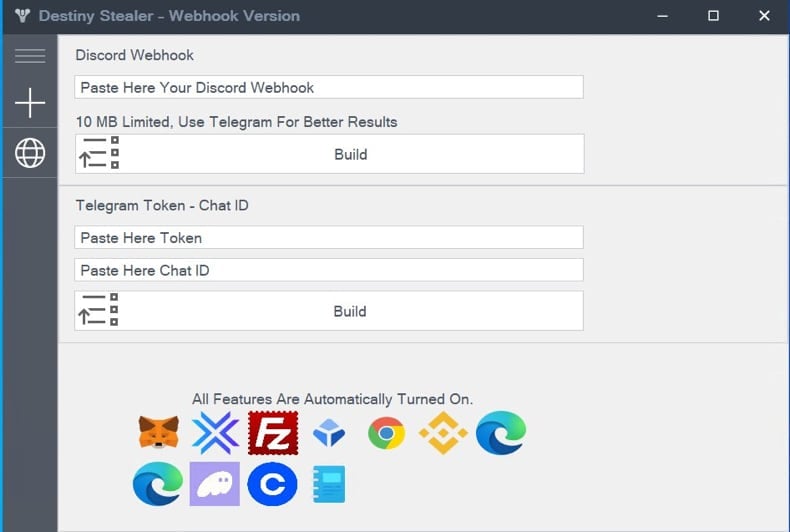
Screenshot of the Destiny Stealer's administration panel:
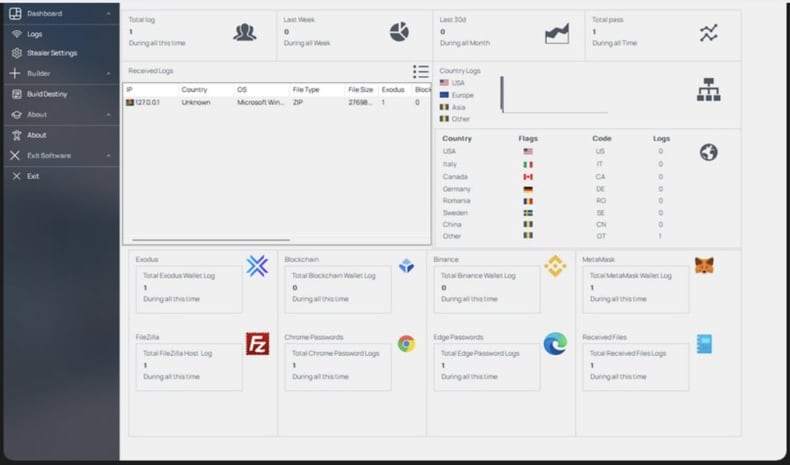
Instant automatic malware removal:
Manual threat removal might be a lengthy and complicated process that requires advanced IT skills. Combo Cleaner is a professional automatic malware removal tool that is recommended to get rid of malware. Download it by clicking the button below:
DOWNLOAD Combo CleanerBy downloading any software listed on this website you agree to our Privacy Policy and Terms of Use. To use full-featured product, you have to purchase a license for Combo Cleaner. 7 days free trial available. Combo Cleaner is owned and operated by RCS LT, the parent company of PCRisk.com.
Quick menu:
- What is Destiny Stealer?
- STEP 1. Manual removal of Destiny Stealer malware.
- STEP 2. Check if your computer is clean.
How to remove malware manually?
Manual malware removal is a complicated task - usually it is best to allow antivirus or anti-malware programs to do this automatically. To remove this malware we recommend using Combo Cleaner Antivirus for Windows.
If you wish to remove malware manually, the first step is to identify the name of the malware that you are trying to remove. Here is an example of a suspicious program running on a user's computer:
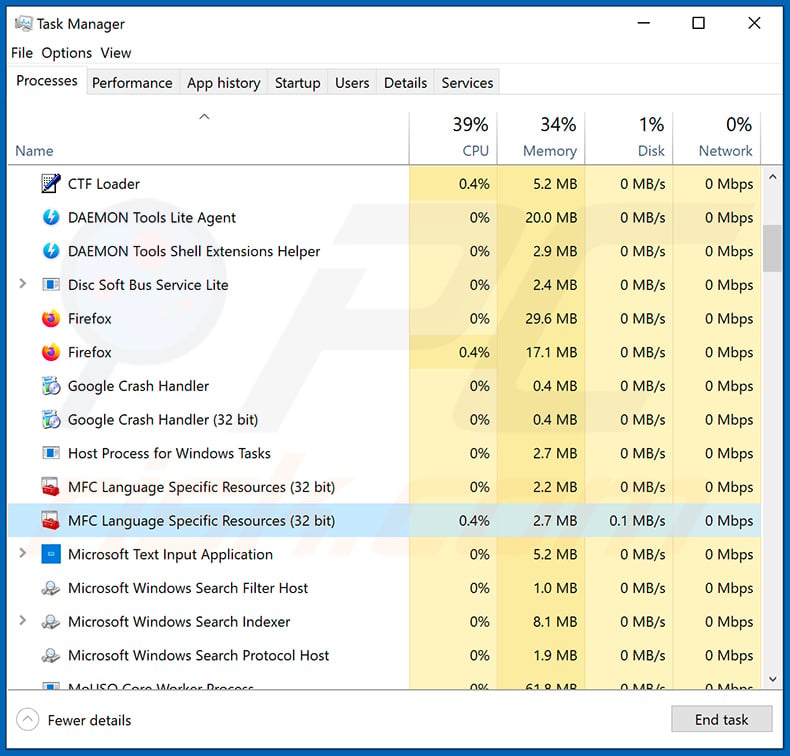
If you checked the list of programs running on your computer, for example, using task manager, and identified a program that looks suspicious, you should continue with these steps:
 Download a program called Autoruns. This program shows auto-start applications, Registry, and file system locations:
Download a program called Autoruns. This program shows auto-start applications, Registry, and file system locations:
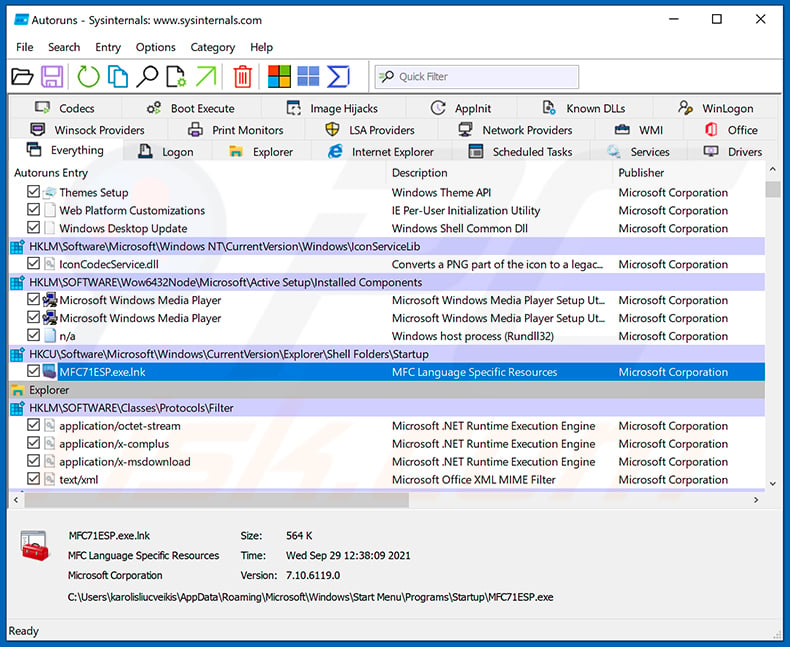
 Restart your computer into Safe Mode:
Restart your computer into Safe Mode:
Windows XP and Windows 7 users: Start your computer in Safe Mode. Click Start, click Shut Down, click Restart, click OK. During your computer start process, press the F8 key on your keyboard multiple times until you see the Windows Advanced Option menu, and then select Safe Mode with Networking from the list.
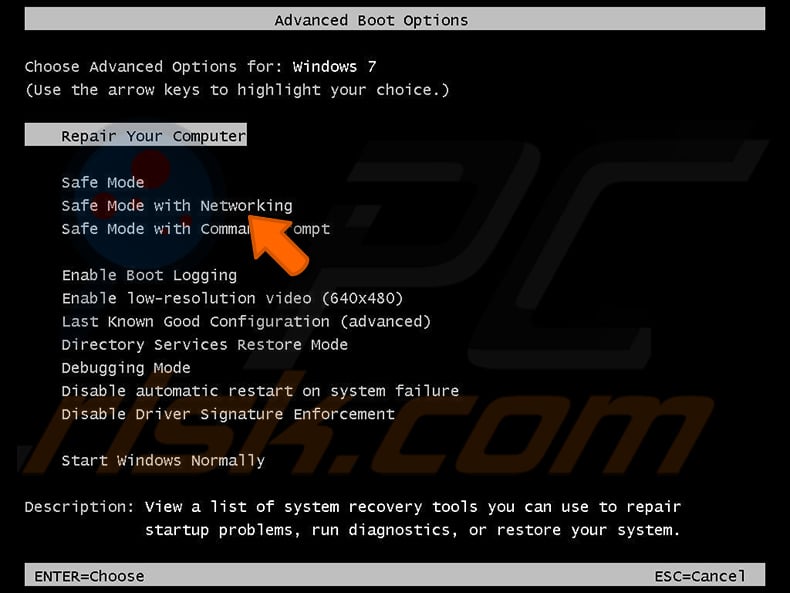
Video showing how to start Windows 7 in "Safe Mode with Networking":
Windows 8 users: Start Windows 8 is Safe Mode with Networking - Go to Windows 8 Start Screen, type Advanced, in the search results select Settings. Click Advanced startup options, in the opened "General PC Settings" window, select Advanced startup.
Click the "Restart now" button. Your computer will now restart into the "Advanced Startup options menu". Click the "Troubleshoot" button, and then click the "Advanced options" button. In the advanced option screen, click "Startup settings".
Click the "Restart" button. Your PC will restart into the Startup Settings screen. Press F5 to boot in Safe Mode with Networking.
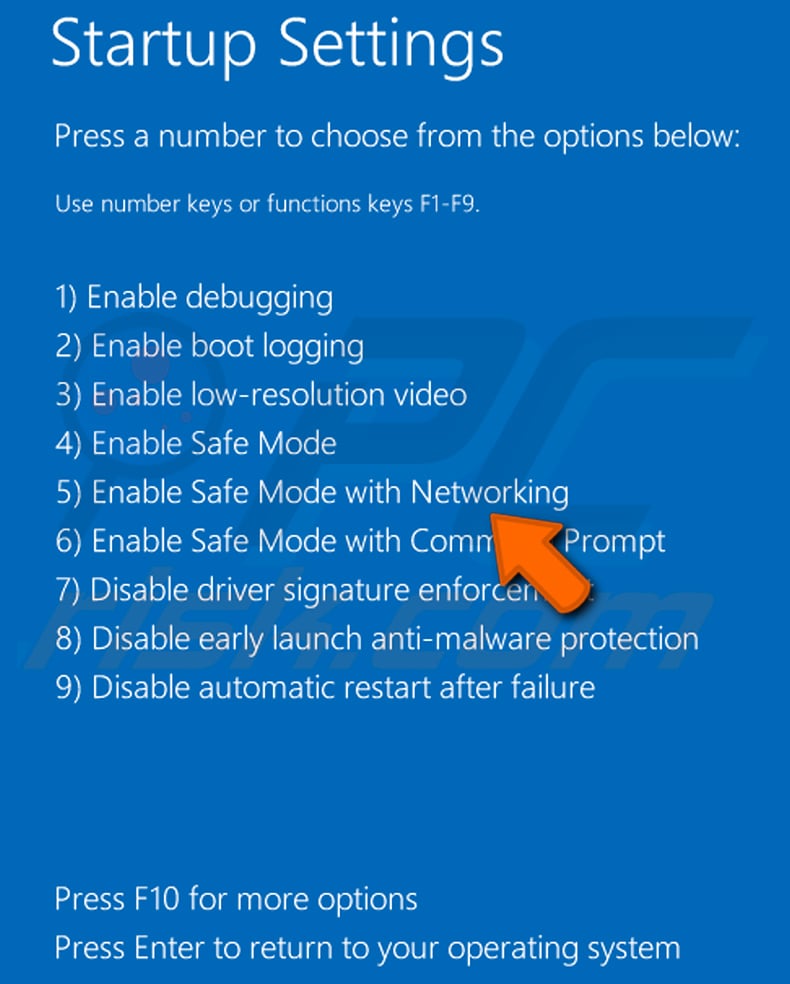
Video showing how to start Windows 8 in "Safe Mode with Networking":
Windows 10 users: Click the Windows logo and select the Power icon. In the opened menu click "Restart" while holding "Shift" button on your keyboard. In the "choose an option" window click on the "Troubleshoot", next select "Advanced options".
In the advanced options menu select "Startup Settings" and click on the "Restart" button. In the following window you should click the "F5" button on your keyboard. This will restart your operating system in safe mode with networking.
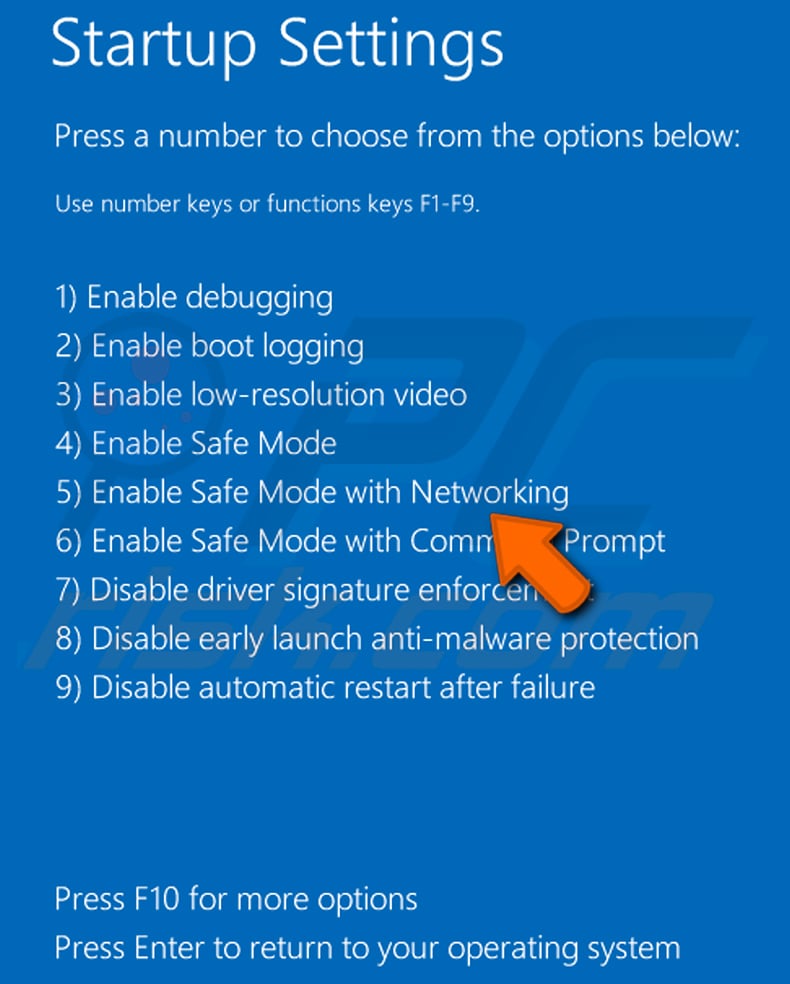
Video showing how to start Windows 10 in "Safe Mode with Networking":
 Extract the downloaded archive and run the Autoruns.exe file.
Extract the downloaded archive and run the Autoruns.exe file.
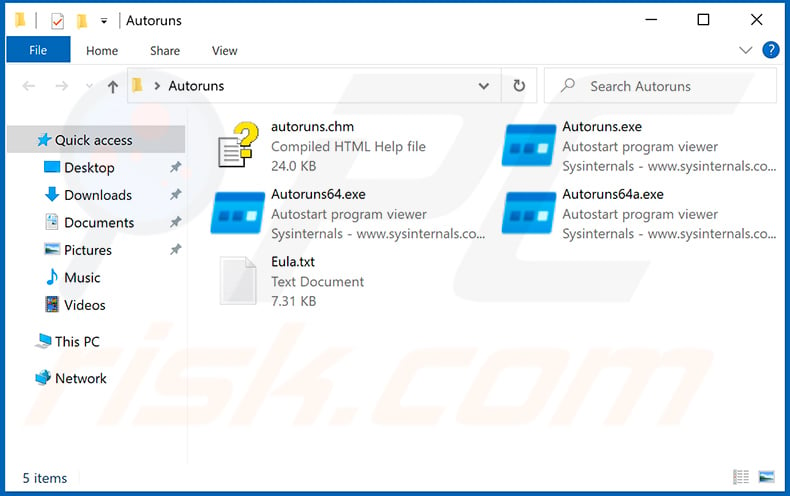
 In the Autoruns application, click "Options" at the top and uncheck "Hide Empty Locations" and "Hide Windows Entries" options. After this procedure, click the "Refresh" icon.
In the Autoruns application, click "Options" at the top and uncheck "Hide Empty Locations" and "Hide Windows Entries" options. After this procedure, click the "Refresh" icon.
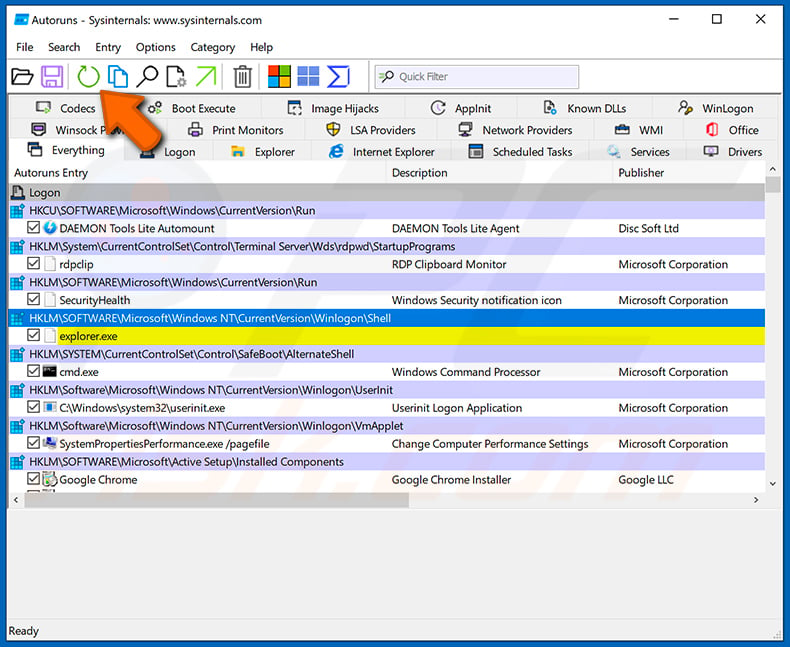
 Check the list provided by the Autoruns application and locate the malware file that you want to eliminate.
Check the list provided by the Autoruns application and locate the malware file that you want to eliminate.
You should write down its full path and name. Note that some malware hides process names under legitimate Windows process names. At this stage, it is very important to avoid removing system files. After you locate the suspicious program you wish to remove, right click your mouse over its name and choose "Delete".
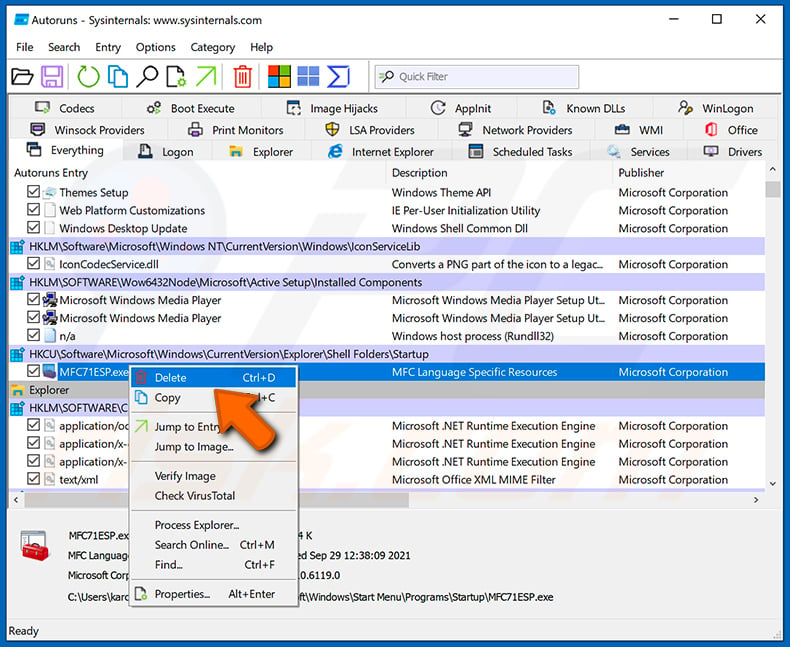
After removing the malware through the Autoruns application (this ensures that the malware will not run automatically on the next system startup), you should search for the malware name on your computer. Be sure to enable hidden files and folders before proceeding. If you find the filename of the malware, be sure to remove it.
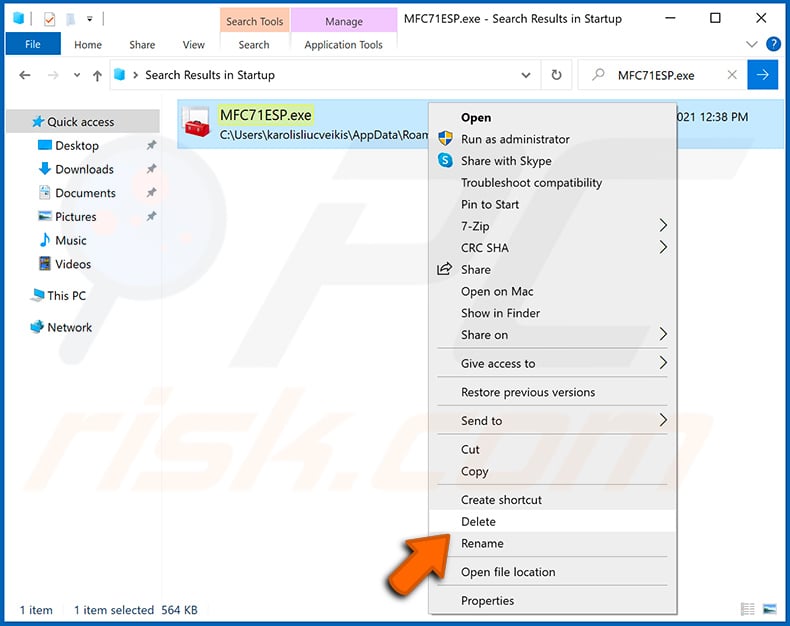
Reboot your computer in normal mode. Following these steps should remove any malware from your computer. Note that manual threat removal requires advanced computer skills. If you do not have these skills, leave malware removal to antivirus and anti-malware programs.
These steps might not work with advanced malware infections. As always it is best to prevent infection than try to remove malware later. To keep your computer safe, install the latest operating system updates and use antivirus software. To be sure your computer is free of malware infections, we recommend scanning it with Combo Cleaner Antivirus for Windows.
Frequently Asked Questions (FAQ)
My computer is infected with Destiny Stealer, should I format my storage device to get rid of it?
If your computer is infected with Destiny Stealer, formatting your storage device can remove the malware. However, it will also remove all the data stored on it. Thus, it is advisable to use a reputable anti-malware tool like Combo Cleaner to try to detect and remove Destiny Stealer.
What are the biggest issues that malware can cause?
Malware can cause data theft, financial loss, identity fraud, system corruption, and unauthorized access to accounts. It can also spread to other devices and deploy more malware on the already infected computers.
What is the purpose of Destiny Stealer?
The purpose of Destiny Stealer is to steal sensitive data from infected systems, including Discord tokens, browser credentials, cryptocurrency wallets, and personal files, which cybercriminals can use for fraud, identity theft, and financial gain.
How did a malware infiltrate my computer?
Cybercriminals spread malware through fraudulent emails, tech support scams, malicious ads, pirated software, and cracking tools. They also exploit software vulnerabilities, infected USB drives, fake social media accounts, deceptive websites, third-party downloaders, and similar channels to distribute malware.
Will Combo Cleaner protect me from malware?
Yes, Combo Cleaner can detect and remove nearly all known malware infections. However, advanced malware often embeds itself deep within the system, making a full system scan required for detection and removal.
Share:

Tomas Meskauskas
Expert security researcher, professional malware analyst
I am passionate about computer security and technology. I have an experience of over 10 years working in various companies related to computer technical issue solving and Internet security. I have been working as an author and editor for pcrisk.com since 2010. Follow me on Twitter and LinkedIn to stay informed about the latest online security threats.
PCrisk security portal is brought by a company RCS LT.
Joined forces of security researchers help educate computer users about the latest online security threats. More information about the company RCS LT.
Our malware removal guides are free. However, if you want to support us you can send us a donation.
DonatePCrisk security portal is brought by a company RCS LT.
Joined forces of security researchers help educate computer users about the latest online security threats. More information about the company RCS LT.
Our malware removal guides are free. However, if you want to support us you can send us a donation.
Donate
▼ Show Discussion